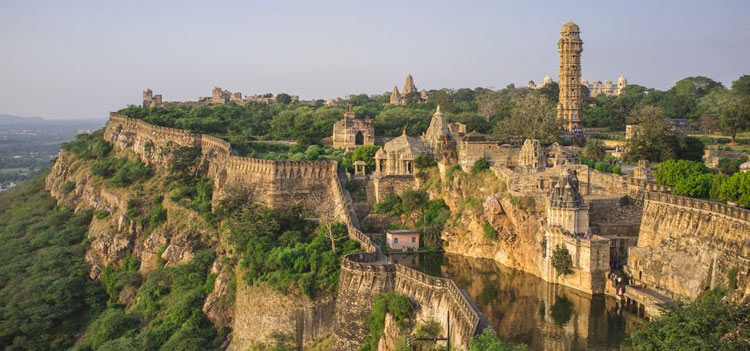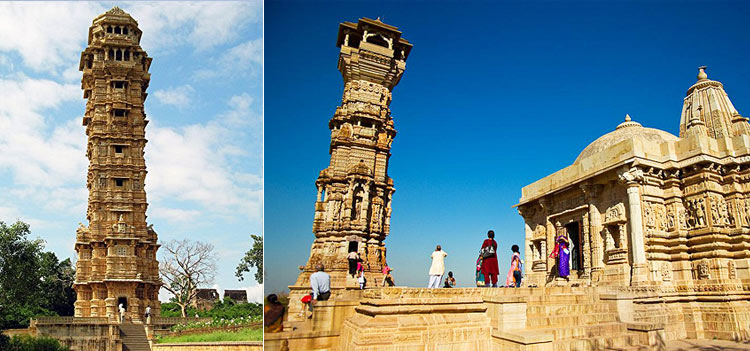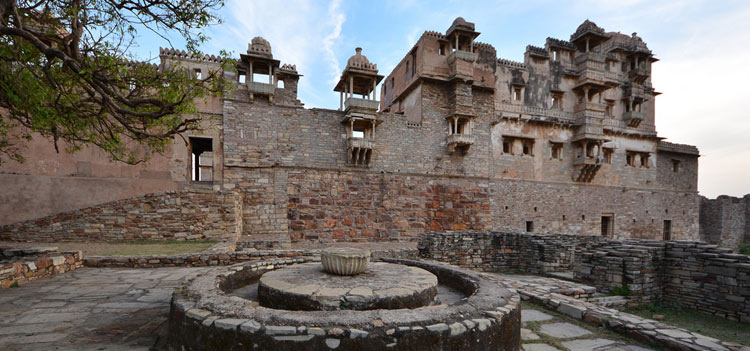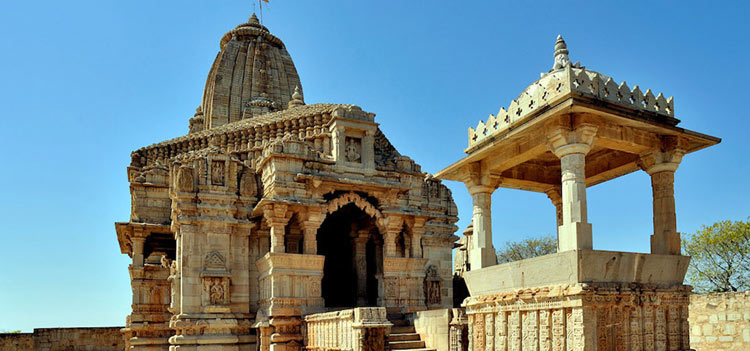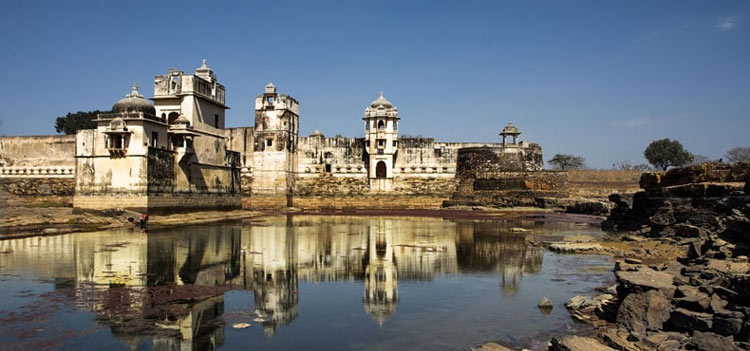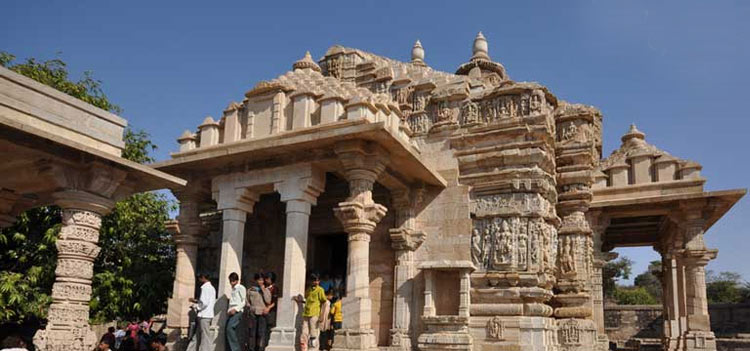Tour Details
On this one day trip of Chittorgarh from Udaipur, visit some of the most wonderful historical sites of Rajasthan at a place which was capital of the Mewar kingdom for more than 800 years (from the 7th to 16th century).
Itinerary
Chittorgarh
Chittorgarh is in the southern part of Rajasthan, lies on the Berach River, a tributary of the Banas, and is the administrative headquarters of Chittorgharh District. It is 112 km from Udaipur and 182 km from Ajmer served as a capital city to the Sisodia clans of Rajputs of Mewar for a long time. The district is a famous tourist destination for its massive fortress claimed to be the largest amoung all the Rajput fort and has witnessed the legendary tale of Queen Padmini's act of jauhar that fascinates most historians and travellers.
Chittorgarh Fort
The fort, plainly known as Chittor, was the capital of Mewar and is today situated several kilometres by road south of Bhilwara. It sprawls majestically over a hill 180 m (591 ft) in height spread over an area of 280 ha (692 ac) above the plains of the valley drained by the Berach River. A winding hill road of more than 1 km (0.6 mi) length from the new town leads to the west end main gate, called Ram Pol, of the fort.
Within the fort, a circular road provides access to all the gates and monuments located within the fort walls. The fort that once boasted of 84 water bodies has only 22 now. These water bodies are fed by natural catchment and rainfall and have a combined storage of 4 billion litres that could meet the water needs of an army of 50,000. The supply could last for four years. These water bodies are in the form of ponds, wells and step wells.
The fort has seven gates (in the local language, gate is called "Pol"), namely the Padan Pol, Bhairon Pol, Hanuman Pol, Ganesh Pol, Jodla Pol, Laxman Pol and the main entry gate of Ram Pol (Lord Rama's Gate). All the gateways to the fort have been built as massive stone structures with secure fortifications for military defense. The doors of the gates with pointed arches are reinforced to fend off elephants and cannon shots. The top of the gates have notched parapets for archers to shoot at the enemy army. A circular road within the fort links all the gates and provides access to the numerous monuments (ruined palaces and 130 temples) in the fort.
Chittorgarh Fort is a large space, and visitors may find it useful to compartmentalise the different sections.
Victory Tower
The Vijay Stambha (Victory Tower) or Jay Stamba, called the symbol of Chittor and a particularly bold expression of triumph, was erected by Rana Khumba between 1458 and 1468 to commemorate his victory over Mahmud Shah I Khalji, the Sultan of Malwa, in 1440 AD. Built over a period of ten years, it raises 37.2 m (122 ft) over a 4.4 m² (47 ft²) base in nine stories accessed through a narrow circular staircase of 157 steps (the interior is also carved) up to the 8th floor, from where there is good view of the plains and the new town of Chittor. The dome, which was a later addition, was damaged by lightning and repaired during the 19th century. The Stamba is now illuminated during the evenings and gives a beautiful view.
Kirti Stambha
(Tower of Fame). Kirti Stambha ("Fame Tower") is a 22 m (72 ft) high tower built on a 9.1 m (30 ft) base with 4.6 ft (1.4 m) at the top, is adorned with Jain sculptures on the outside and is older (probably 12th century) and smaller than the Victory Tower. Built by a Bagherwal Jain merchant Jijaji Rathod, it is dedicated to Adinath, the first Jain tirthankar (revered Jain teacher). In the lowest floor of the tower, naked figures of the various tirthankars of the Jain pantheon are seen in special niches formed to house them. A narrow stairway with 54 steps leads through the six storeys to the top. The top pavilion that was added in the 15th century has 12 columns.
Rana Kumbha Fort Palace
At the entrance gate near the Vijaya Stamba, Rana Kumbha's palace (in ruins), the oldest monument, is located. The palace included elephant and horse stables and a temple to Lord Shiva. Maharana Udai Singh, the founder of Udaipur, was born here; the popular folk lore linked to his birth is that his maid Panna Dhay saved him by substituting her son in his place as a decoy, which resulted in her son getting killed by Banbir. The prince was spirited away in a fruit basket. The palace is built with plastered stone. The remarkable feature of the palace is its splendid series of canopied balconies. Entry to the palace is through Suraj Pol that leads into a courtyard. Rani Meera, the famous poetess saint, also lived in this palace. This is also the palace where Rani Padmini, consigned herself to the funeral pyre in one of the underground cellars, as an act of jauhar along with many the other women. The Nau Lakha Bandar (literal meaning: nine lakh [900 000] treasury) building, the royal treasury of Chittor was also located close by. Now, across from the palace is a museum and archeological office. The Singa Chowri temple is also nearby.
Jain Temples Chittorgarh
History of Jainism is very old. Its roots can be traced back to third or, fourth millennium BC. The legacy has been borne by the twenty four Tirthankaras. Rishabhanatha is known to be the first Tirthankara, the twenty third was Parshvanatha and the last known was Mahavira. Rajasthan started promoting Jainism since the time of Samrat Samprathi in 220 BC. Samrat Samprathi was the grandson of Ashoka and a follower of Jainism. Many Jain temples were built during his rule.
Rani Padmini's Palace (Chittaurgarh)
(Queen's Palace). This palace, a white building, a three storied structure (a 19th century reconstruction of the original), is located in the southern part of the fort. Chhatris (pavilions) crown the palace roofs and a water moat surrounds the palace. This style of palace became the forerunner of other palaces built in the state with the concept of Jal Mahal (palace surrounded by water). It is at this Palace where Alauddin was permitted to glimpse at the mirror image of Rani Padmini, wife of Maharana Rattan Singh. It is widely believed that this glimpse of Padmini's beauty besotted him and convinced him to destroy Chittor in order to possess her. Maharana Rattan Singh was killed and Rani Padmini committed Jauhar. Rani Padmini's beauty is compared to that of Cleopatra and her life story is an eternal legend in the history of Chittor, in particular and of the Mewar state in general.
Meera Bai Temple Chittorgarh
Chittorgarh is the place where Meera Bai was born who was a Rajput princess and is also being well known as a poetess and saint. The princess had given up her lavish lifestyle and dedicated her life in the worship of Lord Krishna. The Meera temple is constructed to be dedicated to her and is a very famous Hindu temple which is a must visit on your tour to Rajasthan. The splendid work of art on the temple attracts a large number of tourists. The temple reflects the Indo-Aryan style of architecture which was very famous in those times and is still a part of our cultural heritage. The Meera Bai temple and the Kumbha Shyam temple are both built on the same ground. On the outer side of the Meera Bai temple you will notice a carved statue of five human bodies with one head which symbolizes the fact that people of all castes and creed are the same and no differences exists among them. It is also of sign of tolerance. The temple has a beautiful statue of Lord Krishna and the Kumbha Shyam Temple has a black colored statue of God Garud. The temple organizes special functions on Meera Mahotsav when many devotees visit the shrine to offer their prayers.
TOUR END